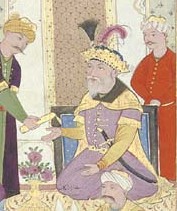Related Research Articles

Nūr ad-Dīn 'Abd ar-Rahmān Jāmī, also known as Mawlanā Nūr al-Dīn 'Abd al-Rahmān or Abd-Al-Rahmān Nur-Al-Din Muhammad Dashti, or simply as Jami or Djāmī and in Turkey as Molla Cami, was a Persian Sunni poet who is known for his achievements as a prolific scholar and writer of mystical Sufi literature. He was primarily a prominent poet-theologian of the school of Ibn Arabi and a Khwājagānī Sũfī, recognized for his eloquence and for his analysis of the metaphysics of mercy. His most famous poetic works are Haft Awrang, Tuhfat al-Ahrar, Layla wa Majnun, Fatihat al-Shabab, Lawa'ih, Al-Durrah al-Fakhirah. Jami belonged to the Naqshbandi Sufi order.

Saadi Shīrāzī, better known by his pen name Saadi, also known as Sadi of Shiraz, was a Persian poet and prose writer of the medieval period. He is recognized for the quality of his writings and for the depth of his social and moral thoughts.

The Aq Qoyunlu or the White Sheep Turkomans was a culturally Persianate, Sunni Turkoman tribal confederation. Founded in the Diyarbakir region by Qara Yuluk Uthman Beg, they ruled parts of present-day eastern Turkey from 1378 to 1503, and in their last decades also ruled Armenia, Azerbaijan, much of Iran, Iraq, and Oman where the ruler of Hormuz recognised Aq Qoyunlu suzerainty. The Aq Qoyunlu empire reached its zenith under Uzun Hasan.
Saib Tabrizi was an Iranian poet, regarded as one of the greatest masters of a form of classical Persian lyric poetry characterized by rhymed couplets, known as the ghazal. He also established the "Indian style" in the literature of his native language, Azerbaijani, in which he is known to have written 17 ghazals and molammaʿs.
Jalal al-Din al-Dawani, also known as Allama Davani, was a theologian, philosopher, jurist, and poet, who is considered to have been one of the leading scholars in late 15th-century Iran.

Abd-Allah Hatefi, commonly known as Hatefi was a Persian poet and nephew of the distinguished poet Jami.

Ahli Shirazi, full name Muhammad ibn Yusuf Ahli Shirazi, was a Persian poet who lived in Shiraz, Iran from circa 1454 to 1535. He is buried in Hafezieh.
Fazlallah Khunji Isfahani, was a Persian religious scholar, historian and political writer. He was born in 1455 in Shiraz, a city in Fars, a region in southern Iran. His father belonged to the Ruzbihan family, which was descended from the Sufi author Ruzbihan Baqli, while his mother belonged to the Sa'idi family. Through both his parents, Khunji belonged to the affluent and influential ulama of Fars, who were respected and protected by the Turkmen Aq Qoyunlu. In 1487, Khunji left Shiraz for the third time for a Hajj. He met Sultan Ya'qub of Aq Qoyunlu near the Sahand mountain and agreed to write the history of Aq Qoyunlu dynasty. When the Safavid shah Ismail I started the Shi'ification of Iran and the persecution of Sunni Muslims, Khunji fled to Transoxiana, where he lived for the rest of his life under the patronage of Timurids and Shaybanids.

Yaqub b. Uzun Hasan, commonly known as Sultan Ya'qub was the ruler of the Aq Qoyunlu from 1478 until his death on 24 December 1490. A son of Uzun Hasan, he became the ruler of the dynasty after the death of his brother Sultan Khalil. The borders of Aq Qoyunlu dynasty remained stable during his reign. In his book Alam-Aray-i Amini, Fazlallah Khunji Isfahani praised him as a decent successor of Uzun Hasan. Ya'qub received praise from other historians for supporting poets and scientists.
Tarīkh-i ʿĀlam-ārā-yi Amīnī is a Persian book on the history of Aq Qoyunlu confederation written by Fazl b. Ruzbihan Khunji. It was composed after the major eastwards expansion of the Aq Qoyunlu, and was completed before 1493.
Tajlu Khanum or Tajli Begum, also known by her title of Shah-Begi Khanum, was a Turkoman princess from the Mawsillu tribe and mother of Tahmasp I.

Mirza Jalal Mohammad, who is best known as Asir-e Esfahani (Asir) and Shahrestani, was a poet in 17th-century Safavid Iran. He was an innovative writer whose oeuvre contains examples of all conventional Persian poetic forms, a grandee at court and a son-in-law of Shah ("King") Abbas the Great.
Qazi Isa Savaji was a Persian bureaucrat from the Savaji family, who was among the leading figures during the reign of the Aq Qoyunlu rulers Uzun Hasan and Ya'qub Beg.

Rustam Beg Bayandur was an Aq Qoyunlu prince, and one of the contesters in 1492–1497 during the dynastic struggle that had erupted following the death of Ya'qub Beg. He was deposed by his cousin Ahmad Beg.
Sharaf al-Din Shah-Mahmud Jan Daylami Qazvini, better known as Mahmud Jan Daylami was an Iranian bureaucrat from the Daylami family, who occupied high offices under the Aq Qoyunlu and the Safavids.

Sultan Murad was the last sultan of the Aq Qoyunlu from 1497 to 1508. After losing his kingdom to the Safavid Shah Ismail I, he fled to Diyar Bakr, where he was eventually killed by Shah Ismail's Qizilbash soldiers at the end of 1514.
Habibi was a late 15th and early 16th century poet. He is regarded as the most important Azerbaijani poet of his generation.
Abdi Beg Shirazi was a court poet, historian, and administrator in 16th-century Safavid Iran, who composed the Persian universal history Takmelat al-akhbar.
References
- 1 2 3 Losensky 2020.
- 1 2 3 Safa 1988, p. 291.
- ↑ Lingwood 2013, p. 112.
- ↑ Lingwood 2013, p. 115.
- ↑ Katouzian 2013, p. 275.